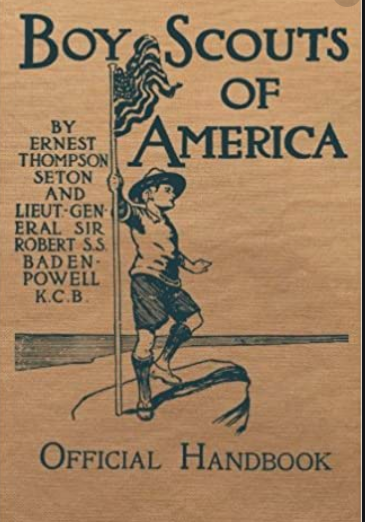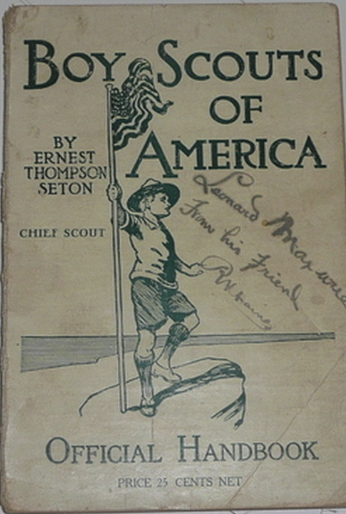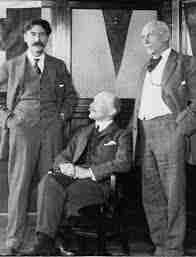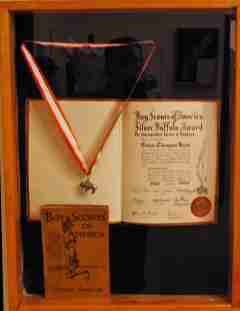Ernest Thompson Seton had a complex relationship with the Boy Scouts.
Many people trace the roots of the Boy Scouts to Seton’s “Ernest Thompson Seton’s Boys” activities that were serialized in the Ladies Home Journal in 1902. Those articles are considered the first edition of Seton’s classic The Birch Bark Roll of Woodcraft. In 1903, Seton published a semi-autobiographical book, Two Little Savages, which is a kind of how-to book for adventurous youth. Legend has it that Rudyard Kipling encouraged Seton to adapt the how-to activities he had begun writing in the Ladies Home Journal and turn them into a novel of sorts with Two Little Savages. Many consider the Birch Bark Roll and Two Little Savages forerunners of the Boy Scout Handbook.
Seton went to England in 1906 as part of his regular lecture tour, with hopes to start Woodcraft there. He was introduced to Robert Baden-Powell, who was also considering starting a youth organization. Seton provided Baden-Powell with the most recent edition of The Birch Bark Roll and left the meeting with the understanding that the two would work together to create the youth organization in England. However, a direct collaboration did not occur, and in 1908, Baden-Powell launched the Boy Scouts in England, drawing heavily on Seton’s The Birch Bark Roll. He had read The Birch Bark Roll and was heavily influenced by it. Seton later claimed that Baden-Powell had appropriated some of The Birch Bark Roll material in Scouting for Boys. Baden-Powell organized the Boy Scouts in England in 1907.
When an effort began to establish Scouting in the U.S., Seton was chairman of the Boy Scouts of America organizing committee. He was named the first Chief Scout, a title that was discontinued after he officially left the BSA in 1915 and was not used again until James E. West, the first Chief Scout Executive, retired.
When Baden-Powell visited the United States in 1910, he was widely regarded as the founder of Scouting. The Boy Scouts of America was vying to be the premier youth organization in the United States and invited Baden-Powell to dinner to suggest that Baden-Powell endorse the BSA over other groups. He received an enthusiastic reception. At a banquet held at New York City’s Waldorf-Astoria, Seton served as master of ceremonies and introduced Baden-Powell as the father of Scouting. Baden-Powell reportedly replied: “You are mistaken, Mr. Seton …. I may say that you, or Dan Beard, are the father – there are many fathers. I am only one of the uncles, I might say.”
Dan Beard, another prolific illustrator, and author, had launched a youth organization called variously the Sons of Daniel Boone or The Boy Pioneers. He also participated in the founding of the BSA and served as National Scout Commissioner for many years. Both were instrumental in shaping the BSA, each claiming to be the true originator. They battled over this point for the rest of their lives.
That night, a famous photograph of Baden-Powell, Seton, and Beard was taken. Even that photograph reflected the conflict among the founders, with Baden-Powell seated with Seton standing to B-P’s right and Beard standing to his left. It appeared that the placement of the men suggested that Seton and Beard were inferior to Baden-Powell in their roles.
As Chief Scout, Seton dedicated himself to developing the Scout Handbook, meeting with Scout troops across the country, and quietly financing the fledgling organization. He was called to put together the first “Official Handbook” of the Boy Scouts of America 1910. This book combined much of Seton’s work with portions of Baden-Powell’s Scouting for Boys. It is sometimes referred to as the Original Edition of the Boy Scout Handbook, as opposed to First Edition published in 1911. Some copies of the Official Handbook are attributed to Seton and Baden-Powell, and some to Seton alone.
Conflict developed between Seton and West, and the organization veered from Seton’s vision of what the organization should be. This conflict eliminated the Chief Scout position, leaving Seton without a place in the organization. (1) Publicly, Seton’s removal as Chief Scout was due to Seton not being an American citizen at the time. He also submitted his resignation, but West insisted there was nothing to resign from, as the position was no longer part of the organization’s structure. BSA President Colin Livingstone wrote a letter to Seton in July 1915 thanking him for his service and wishing him good luck in future ventures, but he was no longer officially associated with the Boy Scouts of America.
Seton determined to refocus on his Woodcraft Indian program, which had not actually been merged into the BSA as commonly reported.
While not officially part of the BSA, Seton remained an inspirational influence on Scouts and Scouters everywhere. In 1926, the BSA established the Silver Buffalo Award. In that first year, 22 Silver Buffalos were awarded. Seton was awarded the seventh Silver Buffalo, with Baden-Powell’s number one, the Unknown Scout number two, and Dan Beard’s number six. The order was determined by West and was considered by some a minor insult to Seton.
By 1935, the 25th anniversary of the BSA recognized various significant contributions of the early founders and ignored or marginalized the contributions of others. This fueled some additional tension, but Seton remained an important figure for Scouting.
After Seton’s death, his widow, Julia M. Seton, clearly recognized that much of Seton’s lasting legacy was related to the Boy Scouts of America when she donated his library and many drawings, paintings, and other artifacts to the BSA to serve as the basic collection of the Ernest Thompson Seton Memorial Library at Philmont Scout Ranch in Cimarron, New Mexico.
Well over 100 years later, Seton’s legacy as a founder of the Boy Scouts of America is clear and widely recognized, both in the United States and many other countries worldwide.
1 Ironically, the title Chief Scout has only been used three times by the BSA. When James E. West retired as chief scout executive, he was granted that title. His successor as chief scout executive, Elbert Fretwell, was also granted the title in retirement.


“Original Edition” Handbook, listing Seton & B-P as authors. Some printings listed nly Seton as authior. See below.



